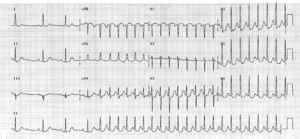Palpitations after a MAZE Procedure: Difference between revisions
Jump to navigation
Jump to search
m (New page: {{NHJ| |mainauthor= '''A.A.M. Wilde, H.H.D. Idzerda''' |edition= 2005:02,72 }} Figure 1|thumb A 75-year-old lady presented with palpitations. Her med...) |
|||
| (3 intermediate revisions by the same user not shown) | |||
| Line 22: | Line 22: | ||
'''What is your diagnosis?''' | '''What is your diagnosis?''' | ||
[[ | [[Puzzle_2007_2_072_Answer|Answer]] | ||
Latest revision as of 20:00, 25 January 2010
| Author(s) | A.A.M. Wilde, H.H.D. Idzerda | |
| NHJ edition: | 2005:02,72 | |
| These Rhythm Puzzles have been published in the Netherlands Heart Journal and are reproduced here under the prevailing creative commons license with permission from the publisher, Bohn Stafleu Van Loghum. | ||
| The ECG can be enlarged twice by clicking on the image and it's first enlargement | ||
A 75-year-old lady presented with palpitations. Her medical history reveals cardiac surgery with a mitral valve repair combined with a MAZE procedure two years prior to presentation. In the past two years she had been without complaints. The current palpitations are associated with dizziness, and a general uncomfortable feeling. Upon physical examination blood pressure is normal and the pulse is regular at 190 beats/min. Because of the high rate, the heart sounds could not be interpreted. The ECG at presentation is shown in figure 1. Vagal manoeuvres were not effective nor was adenosine up to a dose of 18 mg.
What is your diagnosis?
